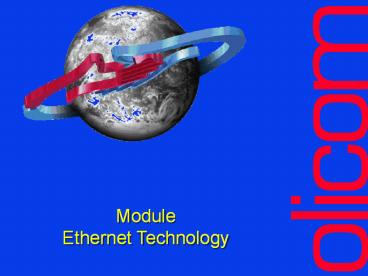Ethernet Technology - PowerPoint PPT Presentation
Title:
Ethernet Technology
Description:
Ethernet Technology 1973 Development begins 1976 First paper on Ethernet published 1977 Ethernet is patented 1979 DEC, INTEL, and XEROX collaborate on Ethernet ... – PowerPoint PPT presentation
Number of Views:323
Avg rating:3.0/5.0
Title: Ethernet Technology
1
Module Ethernet Technology
2
Ethernet - the History
- 1973 Development begins
- 1976 First paper on Ethernet published
- 1977 Ethernet is patented
- 1979 DEC, INTEL, and XEROX collaborate on
Ethernet Version 1. - 1980 Ethernet V.1 is published
- 1980 Xerox ships first Ethernet
- 1982 Ethernet version 2 is published
- 1983 IEEE approves 802.3 standard
- 1985 Ethernet is produces by more than 200
vendors - 1985 Installed base exceeds 20.000 Units
- 1992-1994 Fast Ethernet / 100 Mbps/ Switching
3
IEEE 802.3 standards
10BASE-2 10BASE-5 10BASE-T 10BASE-F
4
Ethernet Access Method
- CSMA/CD
- Carrier Sense
- Listen before trying to transmit - is the cable
free? - Multiple Access
- Many Stations are allowed to use the same
media - Collision Detect
- Be aware of signal collisions - back off when
detected
Signal
Collision
Signal
50 ohm Terminator
50 ohm Terminator
Shared media ( bus )
Computer earth
5
Ethernet Frames
MAC addresses
IEEE 802.3
FCS (4 bytes)
Preample 1010....10 (56 bits)
SFD 10....11 (8 bits)
DA (6 bytes)
Length (2 bytes)
Data . . . . .
(padding)
SA (6 bytes)
(45 - 1500 bytes)
MAC addresses
6
Ethernet Transceiver
- Physical Signalling
- Collision Detect
- SQE Test
- Jabber Function
LAN media
Transceiver
Power
Collision
RX Wires
TX Wires
Drop cable to station (AUI Interface)
7
10BASE-5 Yellow Cable
- Max. 500 m. Cable Segments
- Max. 100 Stations per Cable Segment
- 2.5 m. between Transceivers
- 50 Ohm terminator at each end
2.5 m.
Transceiver
50 ohm Terminator
50 ohm Terminator
(IEEE802.3 media)
Drop cable
Computer earth
AUI interface
8
10BASE-2 Cheapernet Cable
- Max. 185 m. Cable Segments
- Max. 30 Stations per Cable Segment
- Min. 0.5 m. Distance between Stations
- BNC Connectors used to attach stations
- 50 Ohm terminator at each end
50 ohm Terminator
External transceiver Drop cable AUI interface
BNC T Connector Build-in transceiver
9
10BASE-T UTP Cable
- Requires a Cabling Hub
- Max. 100 m. from Station to Hub
Cabling Hub (repeater)
Star topology
100 m. Cable segments
10
10BASE-F Fiber Optic Cable
- Noise Immune
- No Ground Loops
- Long Distance (up to 2Km.)
- Stations connect to a Central Hub
- Max. Two Stations per Cable Segment
- Typically used for Inter-Hub Connectivity
11
Intelligent structured wiring systems
- Increased Flexibility
- Improved Availability
- Inherent Management Capabilities
Cabling Hub
Patch panel
Cabling conducts
Port status - active - not active
- partitioned
Network Management - control - monitoring
RJ-45 outlets
12
10BASE-TF Design Rules
1
2
1
Link segments
2
10BASE-T Max. 100 m.
10BASE-T Max. 100 m.
3
3
4
10BASE-F Max. 1000 m.
10BASE-F Max. 500 m.
4
5
13
Ethernet Transparent Bridges
- Bridges Receive and Buffer the Frames
- Each Side of a Bridge is a Separate Collision
Domain - Bridges Decide to Discard or Forward Packets
- Bridges allow for a more Effective Utilization of
the Overall Bandwidth
Dedicated 10 Mbps
Collision Domain
Collision Domain
Dedicated 10 Mbps
14
Fast Ethernet
- 100 Mbps
- 100BASE-T
- or
- 100VG-AnyLAN
15
Switched Ethernet
Full duplex 10Mbps
100BASE-T
Replaces the old Hub
Ethernet Switch
Existing cabling and adapters
Shared 10Mbps segment
Dedicated 10Mbps segments
16
(No Transcript)































